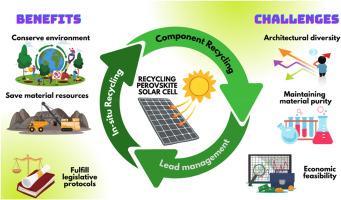Recycling strategies for lead halide perovskite solar cells: Current approaches, challenges, and future directions
IF 6.8
3区 材料科学
Q1 MATERIALS SCIENCE, MULTIDISCIPLINARY
Journal of Science: Advanced Materials and Devices
Pub Date : 2025-08-07
DOI:10.1016/j.jsamd.2025.100969
引用次数: 0
Abstract
Perovskite solar cells (PSCs) have experienced rapid advancements in efficiency and stability, positioning them as viable candidates for commercial applications. However, as PSC technology nears commercialization, the development of standardized end-of-life (EOL) management protocols, particularly for recycling, becomes essential to mitigate environmental and health risks. PSCs contain valuable yet potentially hazardous components, such as lead, which, if not properly managed, can leach into the environment, posing significant risks to ecosystems and human health. With projections indicating a global deployment of up to 100,000 metric tons of lead from PSCs by 2030, effective recycling strategies are critical for preventing long-term contamination. This review discusses the challenges of recycling PSCs, including the complexity of their material compositions and diverse architectures. It also explores various recycling approaches, such as in-situ and layer-by-layer retrieval techniques, focusing on key components like TCOs, ETL/HTL layers, and lead. As PSC technology evolves, recycling strategies must adapt to these innovations. In the final section, the review emphasizes the limitations and challenges faced by recent PSC recycling technologies, and in conclusion, this review provides insights into the future outlook of perovskite solar cell (PSC) recycling, taking into account the anticipated advancements in materials and fabrication technologies.

卤化铅钙钛矿太阳能电池的回收策略:当前的方法、挑战和未来的方向
钙钛矿太阳能电池(PSCs)在效率和稳定性方面取得了快速的进步,使其成为商业应用的可行候选者。然而,随着PSC技术接近商业化,制定标准化的寿命终止(EOL)管理协议,特别是用于回收,对于减轻环境和健康风险至关重要。PSCs含有有价值但有潜在危险的成分,如铅,如果管理不当,可能渗入环境,对生态系统和人类健康构成重大风险。据预测,到2030年,全球将从psc中回收多达10万吨铅,有效的回收战略对于防止长期污染至关重要。本文讨论了聚氯乙烯回收的挑战,包括其材料组成的复杂性和不同的结构。它还探讨了各种回收方法,如原位和逐层检索技术,重点关注关键组件,如tco、ETL/ html层和lead。随着PSC技术的发展,回收策略必须适应这些创新。在最后一部分,本文强调了最近的钙钛矿太阳能电池回收技术所面临的局限性和挑战,最后,考虑到材料和制造技术的预期进步,本文对钙钛矿太阳能电池(PSC)回收的未来前景进行了展望。
本文章由计算机程序翻译,如有差异,请以英文原文为准。
求助全文
约1分钟内获得全文
求助全文
来源期刊

Journal of Science: Advanced Materials and Devices
Materials Science-Electronic, Optical and Magnetic Materials
CiteScore
11.90
自引率
2.50%
发文量
88
审稿时长
47 days
期刊介绍:
In 1985, the Journal of Science was founded as a platform for publishing national and international research papers across various disciplines, including natural sciences, technology, social sciences, and humanities. Over the years, the journal has experienced remarkable growth in terms of quality, size, and scope. Today, it encompasses a diverse range of publications dedicated to academic research.
Considering the rapid expansion of materials science, we are pleased to introduce the Journal of Science: Advanced Materials and Devices. This new addition to our journal series offers researchers an exciting opportunity to publish their work on all aspects of materials science and technology within the esteemed Journal of Science.
With this development, we aim to revolutionize the way research in materials science is expressed and organized, further strengthening our commitment to promoting outstanding research across various scientific and technological fields.
 求助内容:
求助内容: 应助结果提醒方式:
应助结果提醒方式:


